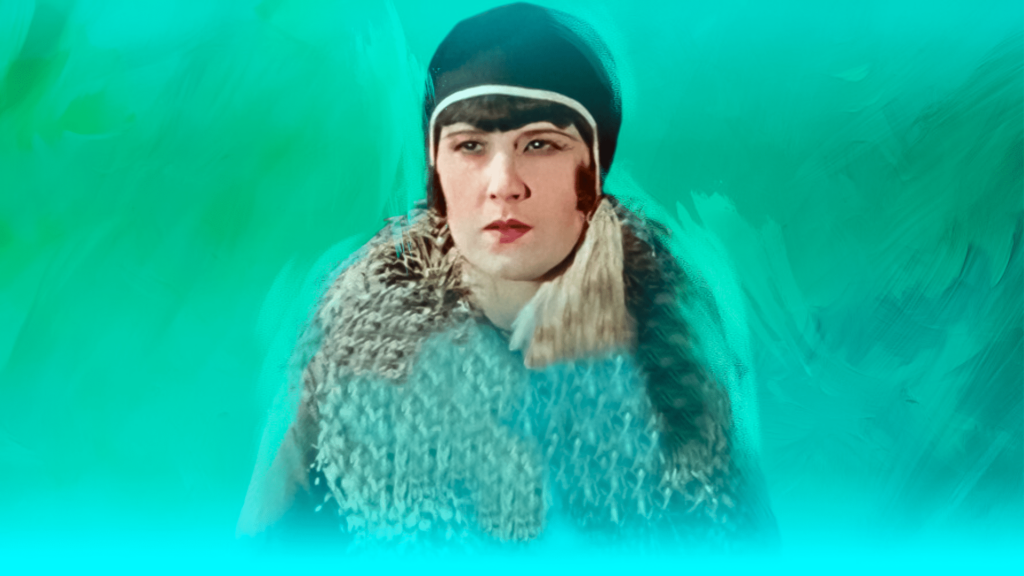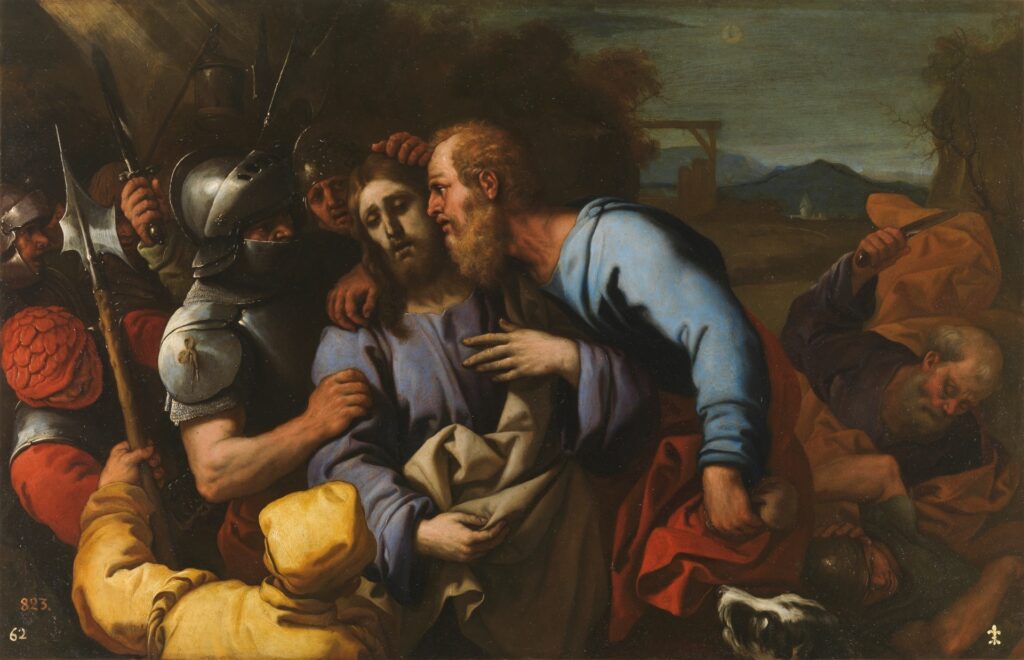The Dehumanization of the Human Face as a Challenge for Bioethics
«The Way of the Strong» (1928)

Another Capra film miraculously recovered, also about “the true human face”
As with Capra’s previous film, “The Matinee Idol” [1] (1928), in the case of “The Way of the Strong” (1928), we also find a film that was thought to be lost. Film historians Stan Taffel and Bryan Cooper, in their video commentary on the film [2], do not hesitate to call its recovery a miracle. A copy was found in the Netherlands, with Dutch intertitles. The restoration work was not limited to optimizing the nitrate coating of the found copy. A rewrite of the texts was necessary, as the Dutch version was very defective. To the point, for example, of changing the protagonist’s name from “Handsome” to Johnny, thus defusing the main paradox of the plot. That is, a gangster with a deformed face who is called, translated from English, “Handsome.”
The similarities between the two films, produced successively in 1928, during a truly prodigious period of creativity by the Italian-born director, do not end there. Both form, in a way, a diptych about what we might call “the true human face,” which constitutes a true challenge for bioethics in times of growing threat of dehumanization. In “The Matinee Idol,” the risk was the mask, the concealment, or the dissimulation of one’s true identity. In “The Way of the Strong,” the matter is more sordid because the question is about a way of life that distorts the very image of humanity in people. Handsome Williams is not simply deformed. He is the result of a way of life, gangsterism, in which the “way of strength” leaves little room for human goodness and reason.
A Capra Film with Humor Banished?
We believe this approach to “The Way of the Strong” is the most appropriate. We can contrast it with another. Jaime Iglesias Gamboa, for example, maintains that “this film marks a turning point in Frank Capra’s career, as it represents the first of his films where humor is completely banished from the plot.”[3] Although the study of classic Hollywood cinema is right in maintaining that this is no less a Capra film, it fails to recognize that the film is not without its moments of humor: Handsome Williams (Mitchell Lewis) jokes easily with his subordinates, and Capra explicitly establishes a visual gag when he measures the ring he intends to give to his girlfriend, the violinist Nora (Alice Day). After trying it on his own ring, a pencil, and a cigar, the mobster can think of no better way than to use the barrel of his gun. Sure enough, it works, and when he goes to the store and shows it to the jeweler, the jeweler throws up his hands in horror, thinking it’s a robbery.
This is a very revealing comic twist, in a way a summary of the contradictory nature of Handsome, a mobster who competes with other bootlegging gangs during the Prohibition years. But he keeps a good heart, which is expressed when he goes to listen to Nora, the blind violinist, every night around nine o’clock. A refuge of sensitivity that he keeps secret. Until the singer at his club, Marie (Margaret Livingstone), discovers him. And since she’s an infiltrator for rival gangster Tiger Louie (William Bailey), whose lover she is, she warns him so he can take advantage of the moment to machine-gun him. Handsome manages to escape, but Nora faints from the shock. Handsome takes her to his club, waits on her, and suggests she perform at the venue. Another humorous moment in which Handsome gets his clients to stop playing jazz and listen to Liszt’s nocturne, Liebestraum, Dreams of Love, performed on violin by Dana and accompanied on piano by Dan (Theodor von Elz). Although he has to force the will of some unruly ones a bit.
“Handsome Williams could bear anything, except the sight of his own face”
The protagonist’s dual condition—his strength and his inability to accept his own image—is the key to the film. The text that introduces him is  clear: “Handsome Williams could bear anything, except the sight of his own face.”[4] The immediate consequence of this is that he cannot tolerate mirrors, neither in his home nor in his establishment. A customer explains this to the girl accompanying him, so that she can put away her hand mirror: “Every time Handsome sees his own face, he goes crazy.” But the mobster, who in the film’s opening scenes has successfully gotten his men to intercept a shipment of alcohol from his rival Tiger Louie—pure film noir—is smitten with Nora, presented as “alone in a world of darkness, made bright for others by music.”
clear: “Handsome Williams could bear anything, except the sight of his own face.”[4] The immediate consequence of this is that he cannot tolerate mirrors, neither in his home nor in his establishment. A customer explains this to the girl accompanying him, so that she can put away her hand mirror: “Every time Handsome sees his own face, he goes crazy.” But the mobster, who in the film’s opening scenes has successfully gotten his men to intercept a shipment of alcohol from his rival Tiger Louie—pure film noir—is smitten with Nora, presented as “alone in a world of darkness, made bright for others by music.”
When Handsome rescues Nora and takes her to his establishment, the contrast between their ways of understanding life becomes evident. To revive her, he’s tempted to give her whiskey, but he throws it to the floor in repentance and offers her water. Then, when she regains consciousness, he innocently tells her “that there should be a law against shooting in the streets.” He confesses that he “could listen to her for hours.” Significantly, a shot shows him caressing his face in front of her, no doubt relieved that she can’t see him. He asks her to play, and as he does so, he notices an erotic painting hanging on the wall of his living room and modestly throws it to the floor. When she finishes playing a melancholic piece, the dialogue is very expressive, reflecting two almost antagonistic ways of approaching life.
Handsome Williams: “It’s not very good for you to be alone… playing in the streets at night.”
Nora: “It’s always night for me. But I don’t mind, the people are so kind.”
Handsome Williams: “I’ll pay you well if you play in my cafe.”
For him, Nora represents a double illusion: enjoying a world of spiritual heights, with the beauty of a woman’s face and classical music, and being able to do so without being seen by her. When Marie attends Nora’s first performance at Handsome Williams’s place, she doesn’t hesitate to rub the latter in her face: “You’re smitten with her, aren’t you, Handsome? You’re lucky she can’t see that face of yours.” Capra doesn’t hesitate to point out that others find the mobster’s face completely monstrous, and with undisguised cruelty, they don’t hesitate to mock him to his face.
“If you ever tell her what I really look like, I’ll kill you”
That hardened world in which the mobster lives his days has a ray of light with Nora’s presence, now enhanced by the proximity of the girl, hired to liven up the café’s repertoire. At the entrance to his shop there is an old woman selling flowers—another sign of candor—and taking advantage of the fact that she was expelling some hooligans who had tried to make a pass at Nora, the gangster buys a bouquet for the girl with the intention of apologizing and assuring her that something like this would never happen again. Upon receiving it, she asks herself, moved: “Oh, Handsome, you are always doing something charming to me… Why are you so good to me?” Moved by this gratitude, she wants to know what his face looks like, which she imagines to be completely ideal. In one of the most moving scenes of the film—and for some commentators of all Capra’s films—she chases him to touch his face with her hands and thus confirm the beauty she senses in the face of the one who is already beginning to be her beloved[5]. Like a new Cyrano de Bergerac, Handsome Williams forces his friend, the pianist Dan (Theodor von Eltz), to take his place, so that she can caress his handsome face by holding it in her own. Nora becomes a pleasant composition of her harmony and nobility.
Thus begins a peculiar love triangle. Handsome Williams threatens his friend: “If you ever tell her what I really look like, I’ll kill you.” Dan responds without a moment’s hesitation: “Would I be a good guy if I betrayed you after all you’ve done for me?” And the mobster closes with a touch of irony, in this case lighthearted because he believes the trick has worked: “Well, keep your face clean-shaven. There’s no telling when I’m going to need it.” However, that balance will prove impossible because Dan himself will fall in love with Nora, who also shows him a more intimate affection with kisses and caresses, thinking he is Handsome. In the aforementioned ring-buying scene, the gangster and the girl were happily having a wonderful time at the fair. While she was recovering, Handsome makes the purchases typical of a great lover, according to the little book the jeweler gives him, GREAT LOVERS. A Guide to Romance: “ring, flowers, perfume, and a fur coat.” While Nora has fallen asleep in the apartment, Dan covers her with a blanket and puts a stool under her feet. She thinks it’s Handsome and is amazed that he’s so quiet. Dan, not wanting to give himself away with words, caresses and kisses her arm. He does the same on her lips.
“Dan, if you’re half as good to her as I wanted to be… you don’t owe me anything”
At that moment, Marie appears with Tiger Louie’s henchmen, who kidnap her. Capra masterfully shows the shadowy realm that the action entails, with a shot of the hallway and the presence of the traitor. With this, the rival mobster pulls off the perfect coup: Handsome won’t interfere with his plans as long as he has the girl.
Tiger Louie, in one of the toughest scenes in Capra’s films, tries to do even more damage to his rival and approaches the room where he’s holding Nora captive, intending to rape her.  For Marie, whom Louie has forced away by firing a shot in the air, this seems unbearable and calls Handsome, directing him to the suburban residence where Nora is being held captive.
For Marie, whom Louie has forced away by firing a shot in the air, this seems unbearable and calls Handsome, directing him to the suburban residence where Nora is being held captive.
The following scenes, without intertitles, show the fight between the two gangs and the final escape of Nora and Handsome, whom Dan rescues, despite the fact that the gangster had beaten him a few scenes earlier because the pianist had confessed that he loved her too. They flee in a car. All three sit in the front seat. Nora faints, and so does Dan, who had been wounded in the arm while freeing Handsome. Near a river, the mobster stops and uses a can to draw water from the stream to revive them. When Nora regains consciousness, she caresses Handsome’s face and reacts in horror. It’s the first time she’s done so, and she believes it can’t be her beloved’s. She turns to the other side, caresses Dan, and sits on his lap, safe and comforted, while the two friends freely exchange meaningful glances about who the girl prefers.
At that moment, Handsome makes a complete surrender in favor of Nora. He asks his friend to take the next road, while he continues to attract the pursuing police car. Marie, once again remorseful, but this time for having betrayed Louie, betrays Handsome, telling the officers that he was the one who shot him. Before leaving Nora and Dan, the gangster gives the pianist the ring he had bought for Nora. He declares: “Dan, if you’re half as good to her as I wanted to be… you don’t owe me anything.” And they shake hands.
The mobster continues to flee. He knows he has no way out and realizes it makes perfect sense to give his life for Nora… and Dan. When she sees his face in the rearview mirror, she exclaims, “Handsome, huh? Not even a blind girl could stand that face.” She smashes it with a punch and then points the gun at his face. As a result of the shot, the car falls into the river next to the road. The police, arriving on the scene, get out to see what has happened. And the last thing they see above the water is the cover of the little book: GREAT LOVERS. A Guide to Romance. Capra wants us to remember that before a story of crimes and misdemeanors, he has told us a love story.
Facing a face represents an invitation to act responsibly
Handsome Williams wanted to complete his sacrifice, with a desire for reparation and to escape the fatalism of the culture of death in which he is embedded, by investing in the lives of others. Dan and Nora were able to escape without being associated with him. But it is much more. In a moment of lucidity, he reconsidered how wrong he was in his behavior with Nora. His ploy to stay with her—making her believe his face was Dan’s—was a complete abuse of the woman’s blindness and her candor. And not only that. Perhaps more decisively, there was a recognition that what disfigured his face was not so much his deformities and scars as his way of life, based on extortion and deceit, violence and intimidation. His good feelings toward Nora, Dan, and others—the film includes a scene in which he gives a coin to someone sitting at a table who doesn’t seem to have the resources to consume—didn’t compensate for the structural malice he was part of.
Catalina Elena Dobre, synthesizing Max Picard’s ideas in her work Das Menschen Gesicht[6], rightly points out that the face is something that is experienced communally, which is why a community of mafiosi—or a society obsessed with the culture of death—ends up destroying it.
This Imago Dei, with which human beings are already endowed in their faces as the most beautiful gift, also implies a responsibility that must be fulfilled in the way humans interact with others and with all of creation. This is why a human face reveals its true beauty only in community; there, when it stands face to face with another human face. The true value of the human face is revealed only in the community, and this is where ethical work begins, because being confronted with a face represents an invitation to act responsibly.[7]
Brief Conclusion
In conclusion, Capra, nearly a century ago, found in cinema a particularly apt medium to warn us about the loss of the face, or rather, about our responsibility for the dignity of the faces of our neighbors. Years later, Max Picard saw that this dehumanization of people’s faces had  occurred massively in the ideology of Nazism represented by Adolf Hitler.[8] And in 1950, he wrote a letter to his friend, the philosopher Gabriel Marcel, with a series of considerations to which bioethics cannot remain indifferent.
occurred massively in the ideology of Nazism represented by Adolf Hitler.[8] And in 1950, he wrote a letter to his friend, the philosopher Gabriel Marcel, with a series of considerations to which bioethics cannot remain indifferent.
Portraits are over; our world is without images: men have lost the power that emanates from the image; The fact that men are together no longer has much virtue either, because they lack a face, gestures, or character, and have lost the possibility of becoming an image, a portrait, a likeness, and the soul itself. And, of course, the somatic begins to dominate: genes and the weight of heredity take over, and that is what now shapes man. And it is not even a problem if scientific theories of heredity emerge when the Image disappears.[9]
It is worth considering and not letting ourselves be carried away by the dominant wave, but rather resolutely committing to a science that is unambiguously inspired by the culture of life.
Gracia Prats-Arolas – Professor and Researcher in Philosophy and Film – Catholic University of Valencia
Jose Alfredo Peris-Cancio – Professor and Researcher in Philosophy and Film – Member of the Bioethics Observatory – Catholic University of Valencia
***
[1] See on this website, The Contrast between Face and Mask and Its Importance for Bioethics in “The Matinee Idol” (“Minnie’s Theater”, 1938)
[2] Sony Blu-ray edition, 2024.
[3] Iglesias Gamboa, J. (2022). The Way of the Strong. In VV. AA., The Universe of Frank Capra (pp. 30-33). Madrid: Notorious Editions, p. 30.
[4] In this case and in the others, we have translated the intertitles in the English version.
[5] Raymond Carney believes that the contrast between this film and Chaplin’s City Lights (1931), two years later, is the key to The Way of the Strong as a contrast between “blindness and vision.” Cf. Carney, R. (1986). American Vision. The Films of Frank Capra. Cambridge, London, New York, New Rochelle, Melbourne, Sidney: Cambridge University Press. (pp. 82-98). In our opinion, this is a revealing element but not the definitive one. As we are showing Handsome Williams, he cares more about Nora and her innocence than the fact that she is blind. That he can be seen as a vagabond and not as a rich man, as Chaplin’s character feared, was incomparably more salvageable than the possibility that Nora might recognize in him a violent man who lives off the war between mafia gangs.
[6] Picard, M. (1929). Das Menschen Gesicht. Munich: Delphin-Verlag. Dobre follows the English translation: Picard, M. (1931). The Human Face. London: Cassell and Company Limited.
[7] Dobre, C. E. (2020). Max Picard. Philosophy as spiritual rebirth. Mexico City: 2020, p. 72. It is appropriate to reflect here the influence that Picard exerted on the philosophy of Enmanuel Levinas. Cf. Sansonetti, G. (2011). Il Volto tra immagine e tracia: Max Picard ed Emmanuel Levinas. In S. Zucal, & D. Vinci, Come all’inizio del mondo. Il pensiero di Max Picard (pp. 69-76). Trapani: Il Pozzo di Giacobbe.
[8] Picard, M. (1947). Hitler In Our Selves. (H. Hauser, Trans.) Hinsdale, Illinois: Henry Regnery Company. French edition, with the significant title of “The Man from Nothing”: Picard, M. (2024). L’homme du néant. (J. Rousset, Trans.) Chêne-Bourg, Suisse: La Baconnière.
[9] Marcel, G., & Picard, M. (2006). Correspondence 1947–1965. Paris: L’Harmattan, p. 96.
Related
 (EN)
(EN)
 (ES)
(ES)
 (IT)
(IT)





